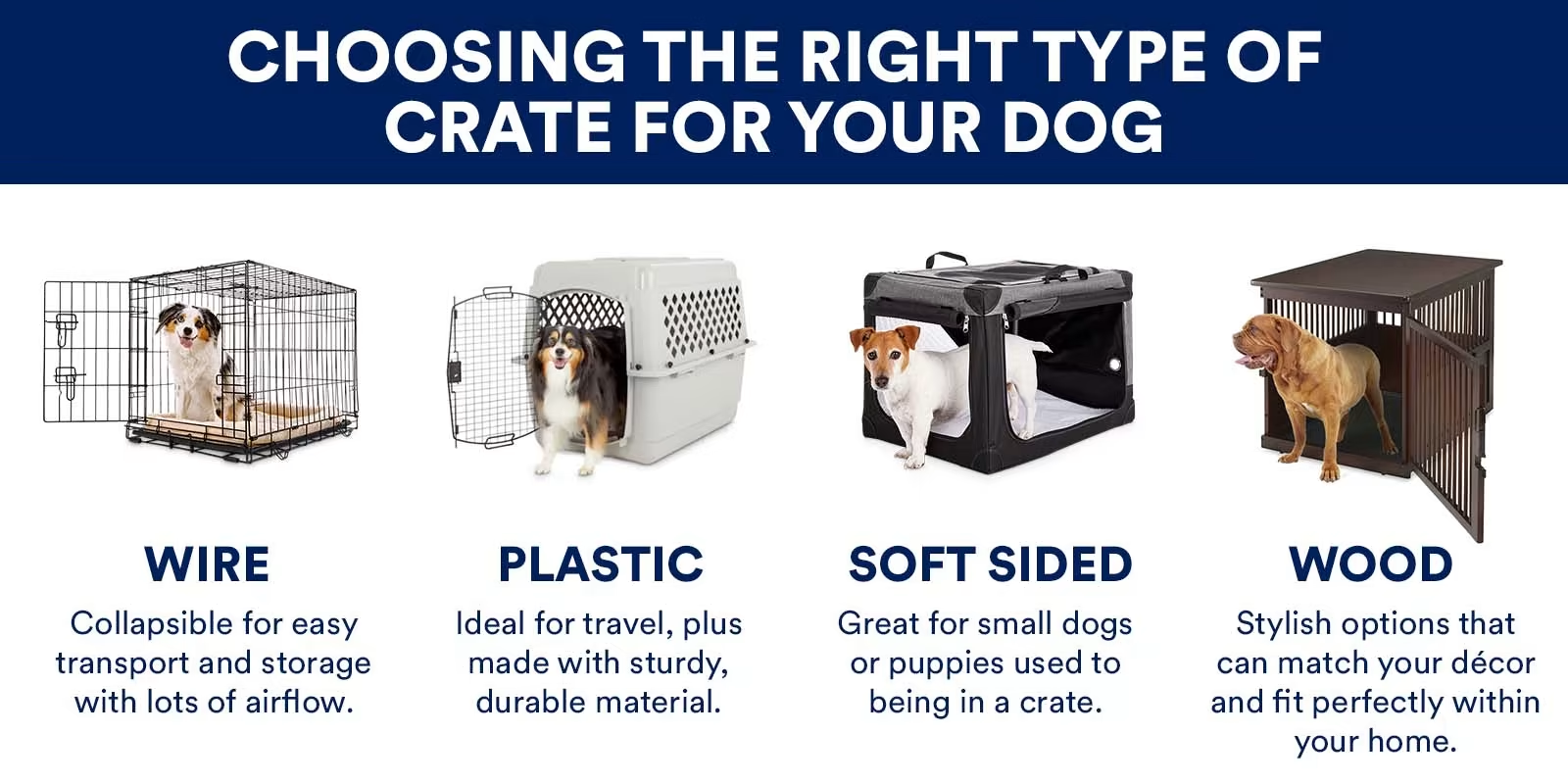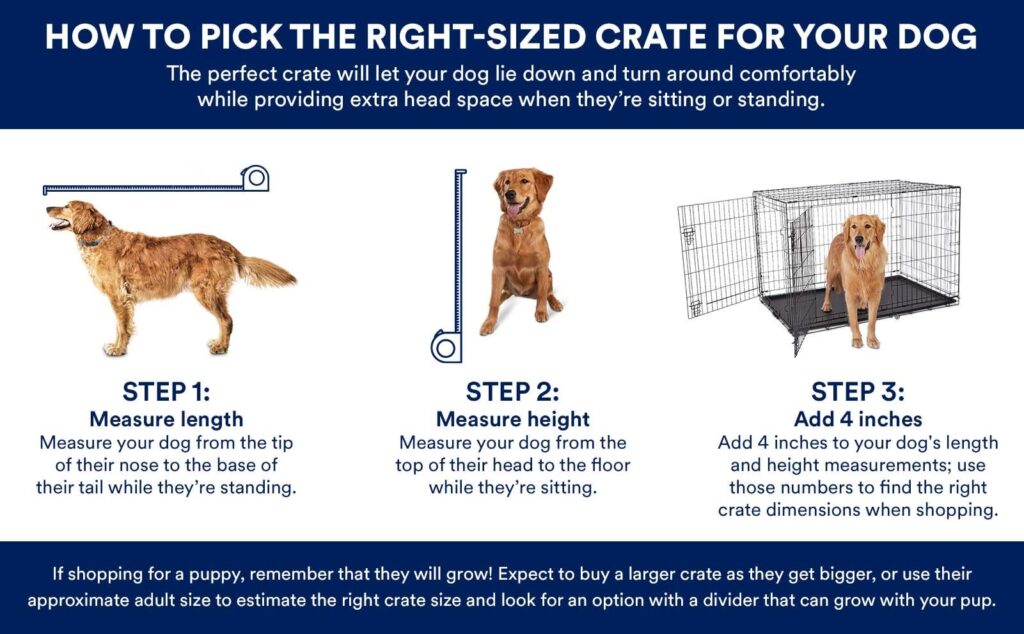When selecting a dog crate for training, choose a size that allows your dog to stand up, turn around, and lie down comfortably. It’s essential to consider your dog’s current size as well as their potential adult size when selecting the crate.
The right size crate will provide a safe and secure space for your dog to rest and relax while aiding in training and behavior management. Selecting the appropriate crate size for your dog is crucial for successful training. A crate that is too large can hinder the training process, while a crate that is too small may cause discomfort and anxiety.
By choosing the right size, you can create a positive environment for your dog to develop good behavior and feel secure in their space. Keep reading to discover how to determine the correct crate size for your furry friend and ensure a successful training experience.
:max_bytes(150000):strip_icc()/best-dog-crates-of-2022-for-every-type-of-pooch-tout-38abc783c4304b33ae0e3b069f9f0608.jpg)
Credit: people.com
Benefits Of Using The Right Dog Crate Size
Choosing the right size dog crate for training is essential for creating a comfortable and secure space for your canine companion. The benefits of using the right dog crate size extend beyond just containing your pet – it impacts their well-being, behavior, and training experience. Let’s delve into the advantages of selecting the appropriate dog crate size for your furry friend.
Ensuring Comfort And Security
A properly sized dog crate ensures that your pet has enough room to stand, turn around, and lie down comfortably. This promotes a sense of security and helps them feel at ease within their own space. When a crate is too large, it may lead to a lack of security, while a crate that’s too small can cause discomfort and stress.
Preventing Anxiety And Stress
The correct dog crate size reduces the likelihood of your pet experiencing anxiety and stress. When the crate is too large, dogs may develop a tendency to relieve themselves in one corner and sleep in another. On the other hand, if the crate is too small, it can lead to feelings of confinement and distress.
Promoting Effective Training
Using the right size crate supports effective training by creating a safe and comfortable environment. It fosters positive associations with the crate and aids in managing your pet’s behavior, such as potty training, preventing destructive habits, and teaching them to settle down on command.
Factors To Consider When Choosing A Dog Crate Size
Selecting the right size dog crate is a crucial step in training your furry friend. Factors such as breed, age, and activity level play a significant role in determining the appropriate crate size. By taking these factors into consideration, you can ensure that your dog feels secure and comfortable in their crate, ultimately aiding in their training progress.
Breed And Size Of Your Dog
Understanding the breed and size of your dog is essential when choosing a crate size. Larger breeds such as Golden Retrievers may require a crate with more space, while smaller breeds like Chihuahuas may feel overwhelmed in a larger crate.
Age And Growth Stage
Consider the age and growth stage of your dog. Puppies grow rapidly, so it’s important to anticipate the eventual size of your dog and choose a crate that can accommodate their future dimensions.
Activity Level And Energy Needs
A dog’s activity level and energy needs should influence the crate size choice. High-energy breeds may appreciate a bit more space to move around comfortably, while calmer dogs may prefer a more cozy environment.
Steps To Determine The Right Dog Crate Size
Choosing the correct size dog crate is crucial for successful training. A crate that is too small can cause discomfort and anxiety for your furry friend, while one that is too big may not provide the security and containment your dog needs. Here’s a step-by-step guide to help you determine the right dog crate size:
Measure Your Dog’s Height And Length
To begin, you’ll need accurate measurements of your dog’s height and length. Measure your dog from the tip of their nose to the base of their tail to determine the correct length. Similarly, measure their height by running the measuring tape from the floor to the top of their head or ears. These measurements will be essential in selecting the appropriate crate size for your dog.
Add Extra Space For Comfort
While precise measurements are important, it’s crucial to consider your dog’s comfort as well. When determining the crate size, it’s recommended to include some additional space for your dog to move around comfortably. Adding about 2-4 inches to the length and height measurements will provide your dog with enough room to stretch out and change positions.
Consider Your Dog’s Lying, Standing, And Turning Space
Remember, a crate is not just for confinement; it should offer a safe and comfortable space for your dog. Take into account your dog’s lying, standing, and turning space when selecting a crate size. Your dog should be able to lie down fully stretched out, stand without crouching, and turn around effortlessly. A crate that meets these needs will promote relaxation and make crate training a positive experience.
By following these steps and carefully considering your dog’s size and comfort, you can choose the right size dog crate that will help streamline the training process and provide a secure and cozy den for your furry companion.

Credit: www.petco.com
Types Of Dog Crates Available
When it comes to crate training your dog, one of the most important aspects is choosing the right size crate. A crate that is too small can be uncomfortable and restricting for your dog, while a crate that is too large may not provide the secure and cozy feeling necessary for effective training. To help you make the right decision, let’s take a look at the different types of dog crates available and their unique features.
Wire Crates
Wire crates are a popular choice among dog owners because they offer several advantages. They are durable, easy to clean, and provide good visibility and ventilation for your furry friend. Wire crates are also collapsible, making them convenient for travel or storage. To determine the right size wire crate for your dog, measure their length from the tip of their nose to the base of their tail, and add a few inches for comfortable movement. Additionally, ensure the height allows your dog to stand up and turn around without any restrictions.
Plastic Crates
If you are looking for a more enclosed and den-like environment, plastic crates might be the perfect choice. They are sturdy, easy to clean, and provide a sense of security and privacy for your pup. When selecting a plastic crate, consider the weight and size of your dog. Your dog should have enough room to stand up, lie down, and turn around comfortably. Make sure to choose a crate with proper ventilation to ensure adequate airflow.
Soft-sided Crates
Soft-sided crates are lightweight, portable, and great for on-the-go dog owners. They are made from durable fabric materials and can be folded for easy storage or transportation. Since soft-sided crates are more flexible, they are recommended for dogs that are already crate trained and relaxed in confined spaces. When choosing a soft-sided crate, measure your dog’s length, height, and width, and opt for a slightly larger size to provide ample room for your dog to move comfortably.
Tips For Crate Training Success
For successful crate training, it is important to choose the right size dog crate. Find a crate that allows your dog to stand, turn around, and lie down comfortably, promoting a positive training experience.
Introduce The Crate In A Positive Way
Start crate training your dog by introducing the crate in a positive way. Make the crate a comfortable and inviting space for your furry friend. Place soft bedding and toys inside the crate to create a cozy environment. Leave the door of the crate open initially so your dog can explore and enter the crate voluntarily. Make sure to place the crate in a location where your dog can still see and interact with family members. This will help your dog feel more secure and less isolated while in the crate. Remember, the goal is to associate positive experiences with the crate.
Use Treats And Rewards
Using treats and rewards is a great way to encourage your dog to enter and stay in the crate. Associate the crate with positive experiences by rewarding your dog with treats and praise every time they willingly enter the crate. Use a command like “crate” or “bedtime” to signal your dog to enter the crate. Gradually increase the length of time your dog spends in the crate before giving them a treat, rewarding them for longer periods of calm behavior. This positive reinforcement will help your dog understand that the crate is a safe and rewarding place to be.
Create A Consistent Schedule And Routine
Consistency is key when crate training your dog. Establish a consistent schedule and routine for crate time. This will help your dog understand when it’s time to enter the crate and when it’s time to come out. Stick to a regular feeding and bathroom schedule, as this will help predict when your dog will need to use the bathroom. Take your dog outside to relieve themselves before placing them in the crate and immediately after letting them out. This will reinforce good bathroom habits and prevent accidents. Additionally, provide your dog with plenty of exercise and mental stimulation outside of crate time to keep them happy and content.

Credit: be.chewy.com
Frequently Asked Questions On Choosing The Right Size Dog Crate For Training
How Big Should A Dog Crate Be For Training?
The dog crate for training should be big enough for the dog to stand, turn around, and lie down comfortably. It should not be too big to allow for bathroom accidents. Proper sizing ensures a safe and effective training environment for your dog’s crate.
Which Type Of Crate Is Best For Dog Training?
The best type of crate for dog training is a sturdy, appropriately sized wire or plastic crate. It should have a secure latch and enough space for the dog to stand, turn around, and lie down comfortably. Ensure it has a cozy crate pad or bedding for comfort.
What Is The Rule Of Thumb For Dog Crate Size?
Choose a dog crate size that allows your dog to stand up, turn around, and lie down comfortably. Ideally, the crate should be about 4 inches longer and taller than your dog’s measurements. It should also have proper ventilation and a secure locking mechanism.
Is It Better To Have A Bigger Or Smaller Dog Crate?
A bigger dog crate is usually better as it allows your dog more space to move around comfortably. It’s important for a dog to have room to stand, turn around, and stretch out in their crate. However, the crate should not be too large as it may lead to potty accidents.
Conclusion
Choosing the right size dog crate for training is crucial in creating a secure and comfortable environment for your furry friend. By considering your dog’s breed, size, and future growth, you can ensure that the crate provides adequate space for them to stand, turn around, and lie down comfortably.
A properly sized crate promotes effective training, helps prevent accidents, and facilitates a positive association with crate time. Remember, investing time in selecting the right crate size will greatly benefit your dog’s overall well-being and training progress.

